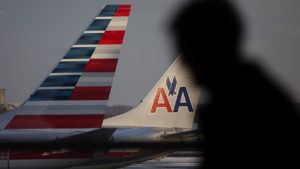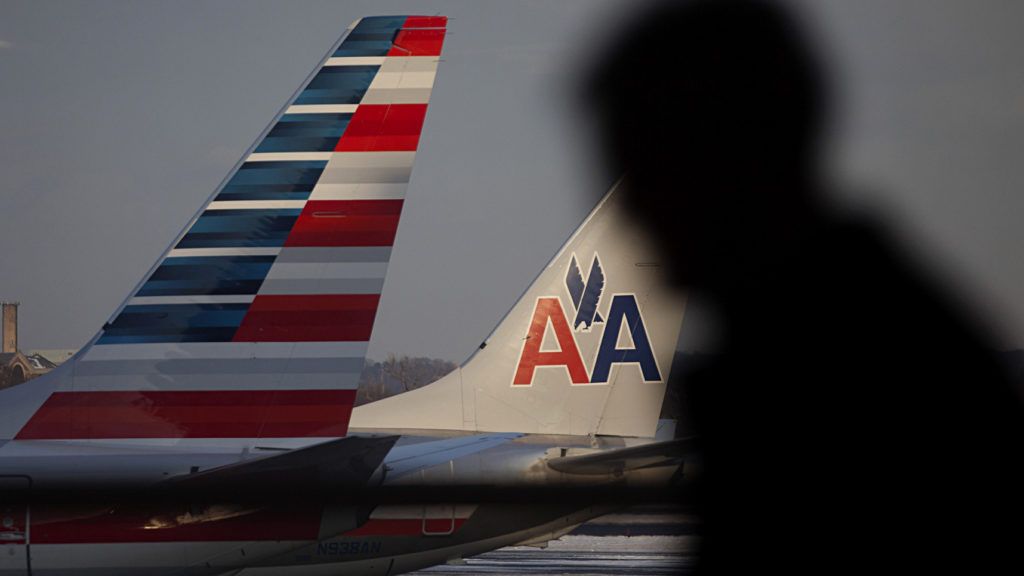From oozing blisters and wheezing to rashes, itchy eyes, and sore throats, numerous American Airlines Group Inc. flight attendants say their new work uniforms are making them sick.
But after a battery of tests and a tense back-and-forth among their union, the airline, and the uniform supplier, it’s still not clear what exactly is behind the rise in health complaints.
The Association of Professional Flight Attendants (APFA), which represents flight attendants for American, has asked the carrier to recall the new garments, which went to 70,000 employees starting in September.
The airline says it has spent more than $1 million for three rounds of toxicological tests that, so far, haven’t turned up any obvious causes for the maladies.
American and the union are now conferring on protocols for further examinations—but the issue grew more contentious last week amid a flurry of communications among the airline, the flight attendants’ union, and the uniform supplier.
The union says about 10 percent, or 2,300, of the flight attendants it represents have reported adverse reactions—among them skin rashes, sore throats, wheezing, fatigue, and vertigo—since they started wearing the new uniform. “This continues to be a serious and growing problem, and is not going to go away without some further remedial action by the company,” the union said on Thursday in a message to members.

American says an employee call center it opened in October has gotten 450 formal complaints of health problems, 350 of them from flight attendants.
The uniform controversy has become such a topic of concern at the airline that several executives have begun wearing the outfit, or parts of it, in an effort to allay fears.
Still, the flight attendants believe that chemicals in the uniform—say, a dye or an adhesive—are probably causing the severe reactions the union says are affecting roughly one in 10 flight attendants.
“I’m very confident that there’s something in that fabric that’s causing this,” said Bob Ross, the union’s national president. “Some [people] react right away. Lots of other people are feeling the effects just by being around the uniforms.”
Ross, a 33-year American veteran, said he himself wore the new uniform’s cotton shirt, “and by the end of the day my entire chest, neck, and arms were red.” It took two showers and disposal of the shirt and its packaging to resolve, he said.
“A hospital gown seems to be the most popular flight-attendant accessory this season.”
A New York-based flight attendant, speaking via online chat on condition of anonymity, said her throat had begun burning on one flight and that she had grown hoarse and broken out in hives. She said she had been to 12 doctor appointments in 40 subsequent days for tests and consultations.
The uniforms have undergone a battery of tests, and the union, airline, and supplier Twin Hill have all hired experts to determine the chemical composition of the uniforms.
So far, testing by American and Twin Hill have not turned up substances that aren’t supposed to be in the clothes or any chemical levels exceeding safety limits, the airline has said.
The union has hired its own toxicologist to examine the results. It has spent more than $20,000 so far and wants American to reimburse it for its expenses, Ross said.
Last week, the airline denied a grievance Ross had filed on behalf of sick attendants. “The safety and comfort of our team members is more important than anything we do, and we know it is at the forefront of the APFA’s mission too,” wrote Cindi Simone, American’s managing director of labor relations.
American has also reimbursed flight attendants who have bought new work clothes similar to the uniform. It says employees may wear their old uniforms, though many no longer have one.
The public contretemps has prompted supplier Twin Hill to complain that it is being maligned unfairly.
In a Jan. 9 letter to Ross, an executive at the Houston-based supplier, a unit of Tailored Brands Inc., denied any problems with the 1.4 million garments it had provided, citing tests by an independent laboratory it hired. Union officials’ public statements “have been both inaccurate and damaging to Twin Hill’s reputation,” wrote Daryl Stilley, a senior vice president at the company.
The union says about 2,300 of the flight attendants it represents have reported adverse reactions.
The company said it plans an all-cotton version of the uniform for those who have had problems with the ones made of wool and polyester—the two main fabrics now being worn.
Ross responded two days later, writing to Twin Hill that its letter had made him “angry and disheartened” and that the union would not be “bullied” in its efforts to protect flight attendants’ health.
Twin Hill has also accused the union of canceling an appointment to jointly select uniform pieces from a Twin Hill center in Houston, while American said it was waiting for the union to agree to a date. The union argues that it wouldn’t make sense to pick pieces from that facility because they may have been manufactured somewhere other than where those causing problems were created.
The union wants to explore the interaction of dozens of chemicals used in the uniforms’ manufacturing, as well as their packaging.
“Say there’s five different chemicals they test, and they all stay within limits—synergistically, how do they interact?” Ross asked.
So far, the problem with the uniforms appears to be concentrated among American Airlines flight attendants.
The Association of Flight Attendants-CWA, which represents about 3,300 flight attendants at American’s Envoy regional subsidiary, has received several complaints, but not to the same degree as the APFA, said AFA spokeswoman Taylor Garland. “Clearly, there is a problem with the uniform rollout at American that requires immediate alternative uniform standards and an overhaul of the uniform rollout,” the union said in an e-mail.
American’s 15,000 pilots have not reported widespread problems with their new wool uniforms from Twin Hill, said Gregg Overman, a spokesman for the Allied Pilots Association.
The health mystery at American isn’t the first such dispute over flight attendants’ uniforms. In 2011, some Alaska Airlines flight attendants made similar complaints about their new uniforms, also from Twin Hill. The next year, several flight attendants sued the supplier, contending their uniforms contained a dye known to cause skin and respiratory irritation. In September, a California court rejected the case and awarded Twin Hill legal fees from a few attendants who did not drop their claims.
Scott Poynter, the Little Rock, Ark., attorney who brought that suit, is now working with about 10 of the American flight attendants, as is Weitz & Luxenberg PC, a New York-based law firm that handles consumer and environmental litigation. Several of the American attendants have also contacted prominent consumer advocate Erin Brockovich in search of help for their situation, Poynter said.
“There’s a lot of comparisons to make between the Alaska Airlines case and the American Airlines case,” Poynter said.
The Alaska Air suit failed, he said, because the judge did not accept the plaintiffs’ view that chemicals in the uniforms were interacting in ways that collectively caused the adverse reactions, from rashes to respiratory trouble. “There’s not a doubt in my mind that the uniforms were the cause. I believe the mixture theory is very solid.”
Still, he hopes to see the results of American’s uniform testing before deciding whether to sue.
“I think that the American flight attendants are right, too,” he said. “But from a legal standpoint, the testing is going to become very important. We’re looking at it.”
Heather Poole, an American flight attendant who lives near Los Angeles and has documented her reactions to the uniform on social media, said many other attendants are reluctant to speak publicly about their own reactions for fear they could be fired or sued.
“A hospital gown seems to be the most popular flight-attendant accessory this season,” she said. “That or an inhaler.”
Was this article valuable?
Here are more articles you may enjoy.


 California Governor Seeks $200M to Replace EV Tax Credits Cut by Trump
California Governor Seeks $200M to Replace EV Tax Credits Cut by Trump  Musk’s X Probed by UK Over Grok’s Thousands of Sexualized Images
Musk’s X Probed by UK Over Grok’s Thousands of Sexualized Images  OpenAI And Microsoft Sued Over Murder-Suicide Blamed on ChatGPT
OpenAI And Microsoft Sued Over Murder-Suicide Blamed on ChatGPT  Surging Oil Tanker Insurance Points to Growing Black Sea Chaos
Surging Oil Tanker Insurance Points to Growing Black Sea Chaos 